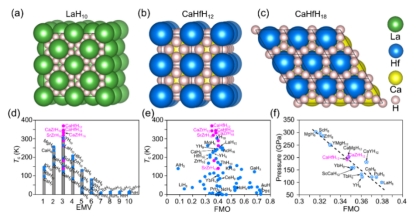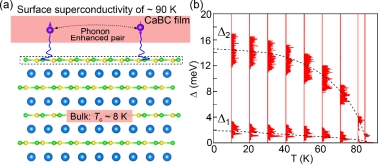Recently, Professor Jia Yu's team from the School of Materials Science and the Theoretical Physics Joint Center of Henan University has made important progress in the research of room-temperature superconductivity of high-pressure hydrides and surface superconductivity of CaBC films, by cooperating with the researchers from Luoyang Normal University and the University of Science and Technology of China. The results were respectively published in the Journals Physical Review B and Nano Letters.

Figure 1: (a) - (c) Structures of hydrides LaH10, CaHfH12, and CaHfH18, respectively. (d) and (e) The superconducting transition temperature as a function of (d) EMV and (e) FMO, respectively, labeling the effective valency and fractional volume of the metal elements in hydride superconductors. (f) The dependence of the minimum stable pressures of metal hydrides with the FMO.
Research on high-temperature superconductivity has been one of the long-sought goals in condensed matter physics and material science. H-rich materials, i.e., hydrides, were proposed to provide an alternative route to realizing high transition temperature (high-Tc) superconductivity. However, although the stability pressures of hydride are difficultly high for experimental synthesis and measurement. Therefore, how to further increase the Tc of the metal hydride to room temperature and reduce the pressure of its synthesis is an important issue in this field. In striving for higher Tc at lower pressures. They proposed two generic guiding rules (Optimal Valency Rule and Optimal Occupancy Rule) surrounding clathrate hydride superconductors to achieve high Tc. By using the particle swarm optimization and first-principles calculations, Prof Jia’s team has not only predicted a collection of new hydride superconductors, including the representative examples of CaHfH12, with Tc of ~ 360 K at 300 GPa, and CaZrH12, with Tc of ~ 290 K at 200 GPa, but also shown that these rules are universal and hold true for binary, ternary and even potentially multiple component metal hydrides. These findings are expected to be instrumental in predictive discoveries of new high-Tc hydride superconductors at lower pressures.
Additionally, Prof Jia’s team also predicted a new class of surface superconducting system consisting of CanBn+1Cn+1 films with Tc increased from 8 K of bulk to ~ 90 K for the thin films [see Figure 2]. Their detailed analysis demonstrates that the symmetry reduction due to surface termination could effectively promote the occupation of surface electronic states as well as the softening of the surface vibrations modes, which work collaboratively to enhance electron-phonon coupling at the surface and yield high Tc in the films. Their results undoubtedly shed some new light on understanding novel or emergent surface/interface superconducting phenomena and promise new routes towards surface superconductivity with high-Tc’s in low-dimensional systems.

Figure 2: (a) Schematic diagram of surface-enhanced superconductivity (b) The superconducting gap of CaBC films varies with temperature, showing that Tc reaches up to ~ 90 K.
The above two works are entitled “Generic rules for achieving room-temperature superconductivity in ternary hydrides with clathrate structures” and “Surface superconductivity with high transition temperatures layered CanBn+1Cn+1 films”, and published in Physical Review B and Nano Letters, respectively. The first author of the paper is Dr. Liangliang Liu is, and the corresponding author is Prof. Yu Jia.
These two works are supported by the National Natural Science Foundation of China. The links of two articles are:
(1)https://journals.aps.org/prb/abstract/10.1103/PhysRevB.107.L020504; (2)https://pubs.acs.org/doi/10.1021/acs.nanolett.2c05038



